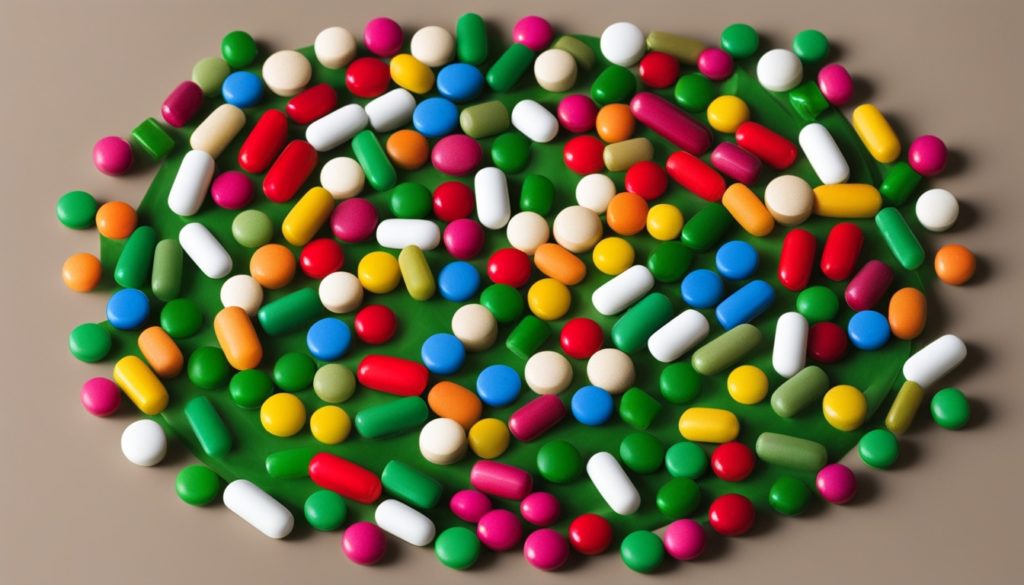Nearly 90% of the 34 million Americans with diabetes tackle Type 2. They often use oral anti-diabetic drugs to manage it. These meds are key for controlling blood sugar. They’re useful when the body still makes insulin. In this guide, we’ll look at different oral diabetes treatment options. We’ll see how they work and talk about their good and bad points.
Key Takeaways
- Oral diabetes medications are vital for managing glucose in Type 2 diabetes patients.
- Metformin, Sulfonylureas, and SGLT2 inhibitors are common medications.
- These drugs sometimes mean changes in lifestyle and need checking by doctors.
- Some can be combined for better results.
- Keeping blood glucose and A1c levels healthy is the main aim of these treatments.
Introduction to Oral Diabetes Medications
Oral diabetes medications are key for those with Type 2 diabetes and prediabetes who can still make insulin. These drugs help keep blood sugar levels in check. Working with doctors and dietitians is crucial to enhance treatment plans.
This may mean using different types of oral diabetes drugs, insulin shots, and changes in lifestyle.

The best oral medications for diabetes are part of a larger plan. This plan not only includes drugs but also big diet and lifestyle changes. Using these drugs wisely can improve the life of someone with diabetes. They can manage their blood sugar better and lower the risk of complications.
Also, knowing about the types of oral diabetes drugs can help patients take an active role in their care. These drugs work in different ways to manage diabetes. Picking the right combination of medications is key for the best results.
How Oral Diabetes Medications Work
Oral diabetes drugs help control blood sugar in people with Type 2 and gestational diabetes. They lower high blood sugar and A1c. This supports patients in managing their disease better.

Mechanism of Action
The mechanism of action for these drugs varies. Some boost insulin production in the pancreas. This increases insulin, helping lower blood sugar. Others stop the liver from making too much glucose. Some medicines make you excrete glucose in urine. Knowing how they work is key to treating diabetes well.
Role in Insulin Resistance
Insulin resistance is a main cause of Type 2 diabetes. Treating it is essential. Oral diabetes drugs make the body’s cells respond better to insulin. They help cells absorb glucose better, using it for energy. This way, these medicines are crucial in fighting insulin resistance and keeping sugar levels stable.
Types of Oral Diabetes Medications
It’s vital to understand how various oral diabetes medications work. Each one plays a different role in controlling blood sugar. This makes it possible to match treatments to what every patient needs.
- Biguanides: Known as Metformin, these lower liver glucose and make the body use insulin better.
- Sulfonylureas: They cause the pancreas to release more insulin, which lowers blood sugar.
- DPP-4 Inhibitors (Gliptins): These boost the body’s incretin hormones, increasing insulin and decreasing glucagon.
- SGLT2 Inhibitors: They stop the kidneys from reabsorbing glucose, which lets the body get rid of it through urine.
Choosing the right diabetes medication depends on a person’s health and their reaction to drugs. Healthcare providers might use several medications together for better blood sugar control. Each drug works in its own way.
Here is how these medications compare:
| Class | Mechanism | Primary Benefit |
|---|---|---|
| Biguanides | Reduces liver glucose production | Improves insulin sensitivity |
| Sulfonylureas | Stimulates insulin secretion | Lowers blood glucose |
| DPP-4 Inhibitors | Enhances incretin hormones | Increases insulin, lowers glucagon |
| SGLT2 Inhibitors | Blocks glucose reabsorption | Eliminates excess glucose |
Getting to know these medications helps patients and doctors make plans. These plans manage diabetes by considering each person’s unique health situation.
Biguanides: Metformin
Metformin is a key medication used to treat Type 2 diabetes. It’s well-known for its effectiveness in controlling blood sugar levels. It does this in two main ways: lessening glucose creation in the liver and boosting how well insulin works in the body.
Benefits and Usage
Metformin is a top choice for those managing diabetes. It lowers the amount of sugar the liver makes and makes insulin work better. This helps keep blood sugar levels in check.
Doctors often recommend it first for Type 2 diabetes. You can take it as a pill, either in a form that works right away or one that works over time. People usually take Metformin twice a day with food. This helps avoid stomach upset like diarrhea and nausea.
Side Effects
Metformin is usually easy to handle, but it can have some side effects. These include stomach issues like bloating, gas, and pain. A very serious, but rare, side effect is lactic acidosis. This is when too much lactate builds up in the blood. It’s an emergency that needs quick treatment.
However, for most people with diabetes, the good points of Metformin are stronger than these risks.
Sulfonylureas
Sulfonylureas are used to control blood sugar in people with type 2 diabetes. They’re effective for lowering blood glucose levels. By boosting insulin from the pancreas, they help keep blood sugar in check.
Common Medications
Glimepiride, glipizide, and glyburide are key drugs in this group. They are more potent and safer than older ones. For more on their benefits, see this source.
Precautions and Side Effects
It’s important to use these medicines carefully. They can cause hypoglycemia, which is dangerous for some people. They may also lead to weight gain, so diet and exercise are key.
Despite their benefits, there could be risks for heart health. Start with a low dose and watch the patient’s sugar levels. Regular check-ups are vital to catch any problems early and keep patients safe.
DPP-4 Inhibitors (Gliptins)
Diabetes care now often includes DPP-4 inhibitors, known as gliptins. They bring unique benefits to patients.
Mechanism and Benefits
DPP-4 inhibitors boost the activity of GLP-1. This hormone helps release insulin and cuts down liver glucose production. Gliptins don’t usually lead to weight gain. This is a key advantage for those managing their diabetes. The DPP-4 inhibitors benefits also involve heart safety and low hypoglycemia risk. So, they’re a choice many tolerate well.
Available Medications
There are several approved gliptins. They meet various patient needs. Some top medications are:
| Medication | Brand Name | Cardiovascular Safety |
|---|---|---|
| Alogliptin | Nesina | Demonstrated |
| Sitagliptin | Januvia | Proven |
| Saxagliptin | Onglyza | Validated |
SGLT2 Inhibitors
SGLT2 inhibitors are now key for many with diabetes. Drugs like Canagliflozin, Dapagliflozin, and others improve blood sugar. They work by making you pee out extra glucose.
Function and Benefits
These meds stop SGLT-2 proteins in kidneys from keeping glucose. So, blood sugar drops. They help control diabetes and offer more perks:
- Weight loss
- Reduction in blood pressure
- Decreased cardiovascular events
- Lowered risk of heart failure
- Slowed progression of chronic kidney disease
Many studies show SGLT2 inhibitors protect the heart. They are great for those with heart failure, no matter their ejection fraction. See the studies here.
Side Effects and Risks
Even with benefits, SGLT2 inhibitors have side effects. Some common ones are:
- Urinary tract infections
- Yeast infections
- Increased urination
- Ketoacidosis (in rare cases)
Doctors need to watch patients on these meds. Regular check-ups can lessen side effects. This lets people gain from better sugar control and health.
In the end, using SGLT2 inhibitors for diabetes helps a lot. It controls sugar well and offers extra health benefits.
Combination Therapy
Diabetes combination therapy is key for optimal blood glucose control. It uses the synergy of diabetes medication. This approach helps healthcare providers make tailored treatment plans that improve patient outcomes.
Benefits of Combining Medications
Using two or more diabetes medications together offers many benefits:
- Enhanced efficacy: This approach targets different body pathways, leading to significantly lower blood sugar levels.
- Reduced side effects: Lower doses of each drug in combination therapy can reduce the chance of negative effects.
- Personalized treatment: Diabetes combination therapy allows for treatment plans customized to meet each patient’s unique needs and health conditions.
Examples of Combination Medications
There are several common combinations used to better manage diabetes:
- Metformin and DPP-4 inhibitors: This combo helps by boosting insulin secretion and lowering glucose production in the liver.
- SGLT2 inhibitors and GLP-1 receptor agonists: These drugs work together to remove more glucose through urine and boost insulin release, offering a comprehensive diabetes management strategy.
- Sulfonylureas and thiazolidinediones: Using these drugs together improves insulin sensitivity and helps stimulate insulin production, helping those with significant insulin resistance.
Conclusion
The world of diabetes treatment has grown a lot. Now, we have many oral medications like Biguanides, Sulfonylureas, DPP-4 Inhibitors, and SGLT2 Inhibitors. Each one has unique benefits for different patient needs. It’s vital to know how these drugs work to control blood sugar.
Doctors and nurses are key in this journey. They tailor medication plans for each patient, focusing on both effectiveness and safety. Their role doesn’t stop at prescribing. They also educate patients, monitor progress, and make needed changes to keep blood sugar under control.
As science moves forward, we expect more advancements in treating diabetes. These will hopefully make it easier and more successful to manage. By staying updated and working with healthcare teams, patients can lead healthier lives.
FAQ
What are oral diabetes medications?
Oral diabetes medications help control blood sugar in people with Type 2 diabetes or prediabetes. They are taken by mouth. These meds work best with diet and lifestyle changes.
How do oral diabetes medications work?
These medications work in different ways to lower blood sugar. Some boost insulin production in the body. Others cut down sugar production in the liver or help remove sugar through urine. Each type has a special way to help manage diabetes.
What are the different classes of oral diabetes medications?
There are several classes, including Biguanides and SGLT2 Inhibitors. Each class works differently to control blood sugar. This variety helps tackle diabetes from multiple angles.
What is Metformin and how is it used?
Metformin, a biguanide, lessens sugar production in the liver. It also makes the body’s insulin work better. It’s mainly used for Type 2 diabetes and is taken with meals to reduce stomach issues.
What are the benefits and side effects of Sulfonylureas?
Sulfonylureas increase insulin from the pancreas. Drugs like Glimepiride and Glipizide help lower blood sugar. However, they may cause low blood sugar and weight gain. A healthy diet and exercise are important when taking these meds.
How do DPP-4 Inhibitors aid in diabetes management?
DPP-4 Inhibitors, like Alogliptin, make a hormone called GLP-1 last longer. This hormone helps lower blood sugar in a weight-neutral way. They’re also known for being heart-safe and rarely cause low blood sugar.
What role do SGLT2 Inhibitors play in controlling diabetes?
SGLT2 Inhibitors, such as Canagliflozin, remove sugar from the blood through urine. They also aid in weight loss and can lower blood pressure. But, there’s a higher chance of getting urinary and yeast infections with these meds.
What is combination therapy in diabetes treatment?
Combination therapy uses more than one oral medication for better sugar control. Mixing Metformin with a DPP-4 inhibitor is a common strategy. The choice of combination depends on the patient’s specific health needs.


